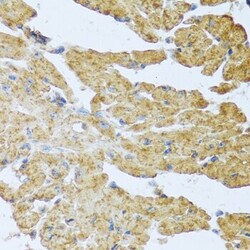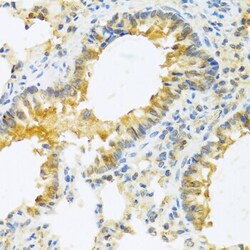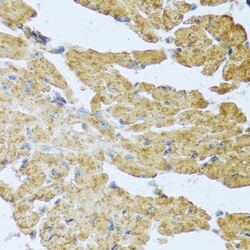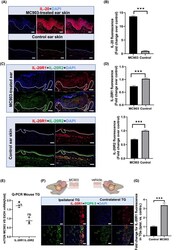Antibody data
- Antibody Data
- Antigen structure
- References [1]
- Comments [0]
- Validations
- Immunohistochemistry [3]
- Other assay [1]
Submit
Validation data
Reference
Comment
Report error
- Product number
- PA5-76967 - Provider product page

- Provider
- Invitrogen Antibodies
- Product name
- IL-20 Polyclonal Antibody
- Antibody type
- Polyclonal
- Antigen
- Recombinant full-length protein
- Description
- The antibody was affinity-purified from rabbit antiserum by affinity-chromatography using epitope-specific immunogen and the purity is > 95% (by SDS-PAGE).
- Reactivity
- Human, Mouse
- Host
- Rabbit
- Isotype
- IgG
- Vial size
- 100 μL
- Concentration
- 1 mg/mL
- Storage
- Store at 4°C short term. For long term storage, store at -20°C, avoiding freeze/thaw cycles.
Submitted references IL-20 promotes cutaneous inflammation and peripheral itch sensation in atopic dermatitis.
Lu Z, Xiao S, Chen W, Zhu R, Yang H, Steinhoff M, Li Y, Cheng W, Yan X, Li L, Xue S, Larkin C, Zhang W, Fan Q, Wang R, Wang J, Meng J
FASEB journal : official publication of the Federation of American Societies for Experimental Biology 2022 Jun;36(6):e22334
FASEB journal : official publication of the Federation of American Societies for Experimental Biology 2022 Jun;36(6):e22334
No comments: Submit comment
Supportive validation
- Submitted by
- Invitrogen Antibodies (provider)
- Main image

- Experimental details
- Immunohistochemistry analysis of IL-20 in paraffin-embedded human liver. Samples were incubated with IL-20 polyclonal antibody (Product # PA5-76967) using a dilution of 1:100. Perform microwave antigen retrieval with 10 mM PBS buffer pH 7.2 before commencing with IHC staining protocol.
- Submitted by
- Invitrogen Antibodies (provider)
- Main image

- Experimental details
- Immunohistochemistry analysis of IL-20 in paraffin-embedded mouse heart. Samples were incubated with IL-20 polyclonal antibody (Product # PA5-76967) at a dilution of 1:100. Results were magnified with a 40x lens.
- Submitted by
- Invitrogen Antibodies (provider)
- Main image

- Experimental details
- Immunohistochemistry analysis of IL-20 in paraffin-embedded mouse lung. Samples were incubated with IL-20 polyclonal antibody (Product # PA5-76967) at a dilution of 1:100. Results were magnified with a 40x lens.
Supportive validation
- Submitted by
- Invitrogen Antibodies (provider)
- Main image

- Experimental details
- FIGURE 3 IL-20 is upregulated in MC903-treated mouse ear skin when compared to control, whereas IL-20 receptors are downregulated. In contrast, IL-20R1 transcription levels are upregulated in sensory trigeminal ganglia (TG) ipsilateral to MC903-treated ear. Representative immunofluorescence staining of IL-20 (A), and IL-20R1 plus IL-20R2 (C) in MC903- and vehicle-treated mouse ear, and their fluorescence intensity analysis (B, D); n = 5 slides/mice ( n = 3 mice). (E) Q-PCR analysis of IL-20R1 and IL-20R2. (F, G) Immunofluorescence staining of IL-20R1 in ipsi. and contra. TG to MC903-treated mice ear as depicted above (F), and IL-20R1 fluorescence intensity analysis (G); n = 5 slides/mice ( n = 3 mice). For (B, D, E and G), means +- SEMs ( n = 3); ns p > .05, * p < .05, and *** p < .001, a two-tailed Student's t -test followed by Welch's correction was used. For (A, C and F), scales = 50 um
 Explore
Explore Validate
Validate Learn
Learn Western blot
Western blot Immunohistochemistry
Immunohistochemistry